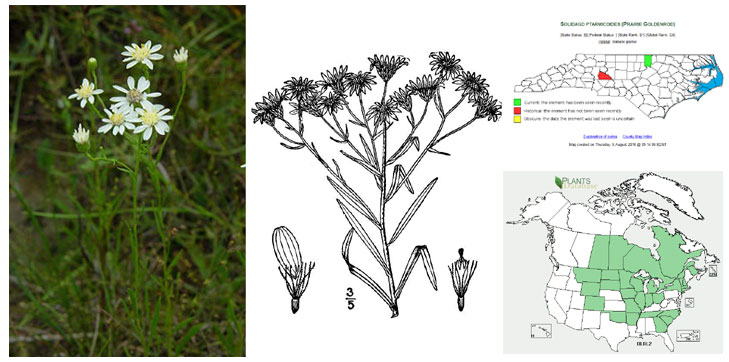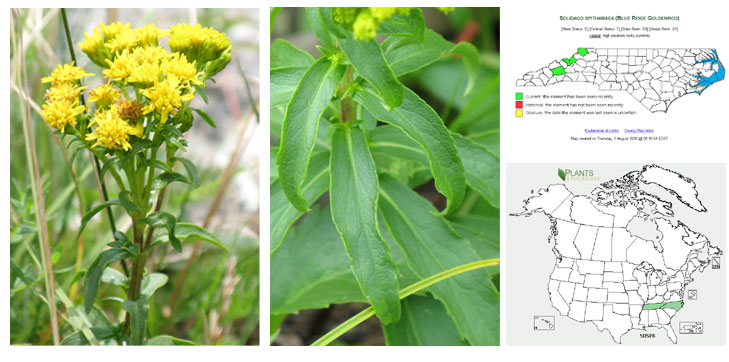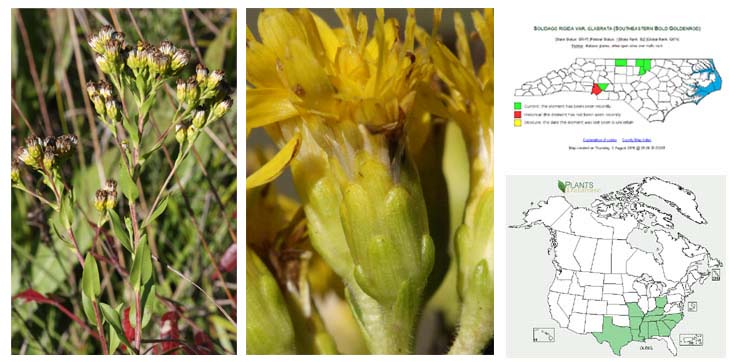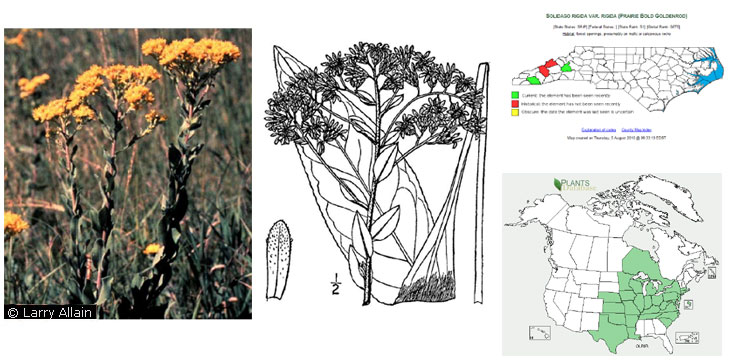Solidago L. (Asteraceae)
Solidago (Asteraceae) is represented by a number of species in North Carolina. The federally listed species Solidago spithamaea (Fed T) is one of only three species in the genus in North Carolina that exhibit corymbiform arrays of heads. The other taxa include the state listed S. ptarmicoides (State E) and two varieties of Solidago rigida, all of which are treated by some as separate species in Oligoneuron, although molecular data have not resolved the issue of generic circumscription (Nesom 2020 [Phytoneuron 2020-24]). Semple & Beck (2023) suggested that: "Retaining Oligoneuron as a separate genus would require
subdividing Solidago into a number of segregate genera, each of which would be difficult to define morphologically" [Phytoneuron 2023-41].
Federally listed taxon—
Solidago spithamaea (Fed T, State T | S1 G1)
Habitat. High elevation rocky summits.
Range. Endemic to the southern Appalachians.
Additional resources. NHP | Recovery plan | 5-yr review
Key to corymbiform Solidago in North Carolina
Key adapted from Weakley (2008). Photos by Krings, unless otherwise indicated. Line drawings from Britton & Brown (1913). Maps courtesy of USDA PLANTS and the North Carolina Natural Heritage Program.
1. Rays white; leaves linear-lanceolate to linear-oblanceolate, the longer (10–) 15–20× as long as wide; pappus bristles slightly to strongly clavellate-thickened...S. ptarmicoides 


Habit of Solidago ptarmicoides (Photo: Krings)

Habit of Solidago ptarmicoides (Photo: Krings)

Stem of Solidago ptarmicoides (Photo: Krings)

Stem and leaves of Solidago ptarmicoides (Photo: Krings)

Leaves of Solidago ptarmicoides (Photo: Krings)

Solidago ptarmicoides (Photo: Krings)

Solidago ptarmicoides (Photo: Krings)
Solidago ptarmicoides [
Oligoneuron album]
(rare [State E, S1 G5]; prairie-like areas over mafic or calcareous substrate; Pd)
1’. Rays yellow; leaves oblong, elliptic, obovate, or spatulate, 2–8× as long as wide; pappus bristles not clavellate thickened...2.
2. Larger leaves obovate, 5–10 cm long, 1.5–4 cm wide, with prominent teeth; plants small, 0.5–4 dm tall...S. spithamaea* 


Habitat of Solidago spithamaea (Photo: Krings)

Stem and leaves of Solidago spithamaea (Photo: Krings)

Leaves of Solidago spithamaea (Photo: Krings)

Leaves of Solidago spithamaea (Photo: Krings)

Habit of Solidago spithamaea (Photo: Krings)

Solidago spithamaea (Photo: Krings)

Solidago spithamaea (Photo: Krings)
Solidago spithamaea* (rare [Fed T, S1 G1]; high elevation rocky summits; Mt; late summer to fall)
2’. Larger leaves elliptic-oblong, 6–25 cm long, 2–10 cm wide, with small, obscure teeth; plants robust, 4–15 dm tall...3.
3. Outer series of involucral bracts glabrous on the back (glabrous to short-ciliate on the margin); leaf undersurface glabrous to somewhat hispid (0–20 hairs per sq. mm) (the margins and midrib beneath often more densely pubescent); stems glabrous to somewhat hispid (0–25 hairs per sq. mm)...S. rigida var. glabrata 


Habit of Solidago rigida var. glabra (Photo: Krings)

Stem of Solidago rigida var. glabra (Photo: Krings)

Stem and leaf of Solidago rigida var. glabra (Photo: Krings)

Leaf edge of Solidago rigida var. glabra (Photo: Krings)

Solidago rigida var. glabra (Photo: Krings)

Solidago rigida var. glabra (Photo: Krings)

Solidago rigida var. glabra (Photo: Krings)
Solidago rigida var.
glabrata [
Oligoneuron jacksonii]
(rare [State SC-V, S2 G4]; glades, barrens, prairie-like areas over mafic/calcareous substrate; Mt, Pd)
3’. Outer series of involucral bracts pubescent on the back (short-ciliate on the margin); leaf undersurface hispid (7–50
hairs per sq. mm); stems glabrous to somewhat hispid (10–70 hairs per sq. mm)...S. rigida var. rigida 
 Solidago rigida
Solidago rigida var.
rigida [
Oligoneuron rigidum]
(rare [State T, S1 G5]; glades, barrens, prairie-like areas over mafic/calcareous substrate; Mt, Pd)




